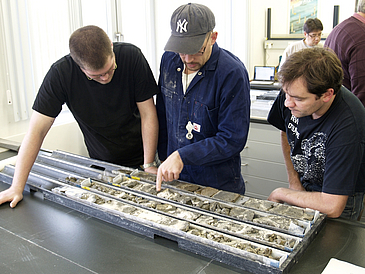MARUM researcher Dr.Thomas Felis and a group of international marine scientists present a new piece of the global climate puzzle: They demonstrate that, unlike today, the tropical South Pacific was affected by El Niño events towards the end of the last ice age. The team investigated a fossil coral core that was drilled in the scope ot the Integrated Ocean Drilling Program IOPD offshore Tahiti. The study is now being published in the online journal Nature Communications.
The final stage of the last ice age about 18,000 years ago the ice shields that then covered Canada, Greenland, and Scandinavia discharged massive icebergs into the Atlantic Ocean. This freshwater pulse weakened Atlantic Ocean currents for several millennia and even influenced the Asian monsoon. Now, scientists are able to explain impact of the event in the Northern Atlantic in the tropical Pacific - like for example the up and down of the El Niño-Southern Oscillation (ENSO) which today causes global weather anomalies.
“For the first time, our detailed investigations show that, in contrast to today, Tahiti was part of the ENSO sphere 15,000 years ago,” as lead author Dr.Thomas Felis summarizes the most important finding. The new data reveal that back then sea-surface temperatures in the tropical Pacific fluctuated in a typical ENSO mode of two to five years.”
“The singular aspect of this work is that the part of the core we investigated is only 60 centimetres long. However, it spans 22 years of continuous coral growth,” the geoscientist points out. 15,000 years ago the coral grew in the northern part of the reef system that borders the island of Tahiti; presumably in a water depth of less than five metres. In late 2005, when the IODP drilling vessel cored the coral, it was located 113 metres below current sea level.
“This is a unique snapshot from our past climate”, Thomas Felis says. Thanks to the coral core, 22 years of weather and climate can now detailed be reconstructed. This forms the basis for the scientists to document for the first time the variations in temperature typically for the El Niño rhythm in the tropical Pacific.
To substantiate their findings, the coral experts cooperated with climate modelers, whose results fit well with the coral data: The computer model definitely mirrors the ENSO rhythm.
More information:
Albert Gerdes
ECORD Science Operator Public Relations
Phone: +49 421 218-65540
Email: agerdesprotect me ?!marumprotect me ?!.de


